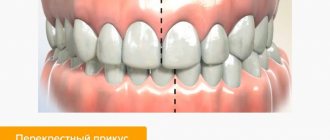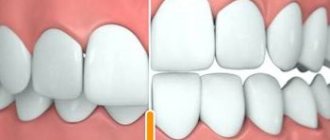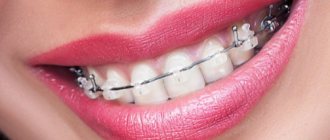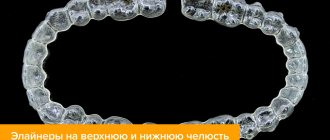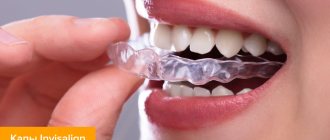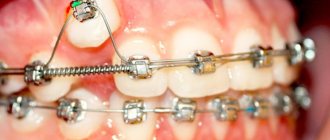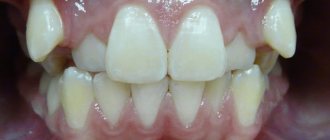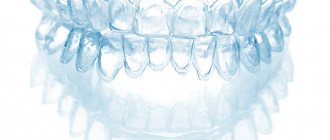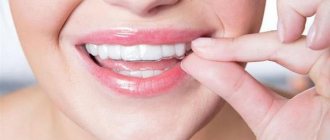Many people are faced with such an unpleasant problem as malocclusion. Almost 85% of the country's population has this pathology. Until the recent past, it was possible to get rid of malocclusion exclusively with the help of braces, and a significant effect was achieved only when used in adolescence or childhood. But technology is developing rapidly and now there are many ways to correct bites even in adults.
When does a child need to have their bite corrected?
Parents should note all important details in the child’s unconscious behavior. Pay attention to how the child breathes, whether his mouth is often open, whether he snores in his sleep, what position the lower jaw is in, whether he likes to gnaw hard objects - these factors have a huge impact on the development of dental pathologies. Take a closer look at the posture and structure of the foot, these are also important indicators of possible violations. Did you find any deviations? Consult a professional.
Risk factors
- difficulties with nasal breathing, for example, due to adenoids or allergies;
- spinal column deformity;
- bad habits;
- genetic predisposition to dental anomalies;
- diseases of the central nervous system.
If the listed risk factors are present, treatment will be effective only with the participation of doctors from related fields. Therefore, it is best to contact myofunctional centers, which unite orthopedists, pediatric dentists, orthodontists and osteopaths. The joint work of specialists guarantees accurate diagnosis and successful resolution of the issue.
Age for correcting malocclusion in children
You should think about visiting an orthodontist after teething. If necessary, the specialist will prescribe a comprehensive examination and radiography to identify the causes of dental anomalies. Then you should get advice from doctors in related fields. Specialists will determine contraindications, the likelihood of complications and assess the condition of the baby’s entire body. Based on the data obtained, the orthodontist will draw up a treatment plan for approximately 2 years with monthly clinic visits.
How to fix teeth without braces
Orthodontists have many techniques in their arsenal to help straighten teeth or correct bites. I work with children and adults. Without braces, using aligners, more than three hundred of my patients have already received effective help; their problems have been successfully resolved.
Plates for children
<
If occlusion defects or crooked teeth are found in a child, then it is rational to use special plate devices or select other methods. I developed a training course on the correction of malocclusions using aligners in children, which became popular in the country and abroad. During the visit, we will discuss the nuances of the problem and select a method for your baby that is gentle and corrects deficiencies. A child’s bones are plastic, so changes occur quickly - results are visible within a couple of months. In addition, at a tender age, only teeth correction without braces is possible. The disadvantages of such treatment are minor temporary changes in diction, increased salivation during the adaptation stage.
Aligners
You can straighten your teeth without braces using aligners. These are plastic trays that help align units and form a correct bite.
They are made of transparent material, so they are practically invisible on the teeth. Aligner rulers are made individually based on the results of 3D computer modeling based on digital impressions. The loads are accurately calculated, the pressure on each tooth is determined, and each stage of the correction process is predicted. Easyliners and invisaliners are improved designs made from hypoallergenic synthetics. They allow you to easily brush your teeth and can be removed and put on yourself. The wearing period is from 8-10 months, 20-24 aligners may be needed, the structures are replaced at different stages of pathology correction. The method is effective and its cost is paid off by the quick results and patient comfort. Disadvantages of treatment are the need to frequently change mouth guards and pain during adaptation. Modern aligners are durable, flexible, and their care is hassle-free.
Functional devices
A visit to the orthodontist will help you figure out how to straighten your teeth without braces. It is possible to use myofunctional devices. I successfully work with trainers and activators. There are models of trainers that will help correct bites at an early age - from 3-4 years. This is a simple and painless treatment option for the baby. Ordinary plates correct irregularities, and trainers relieve muscle tension, correct the position of teeth, and the bite is corrected smoothly, without effort. Facial features become proportional.
Of course, there is now a huge selection of offers from clinics and dentists. And sometimes it is very difficult to choose who to go to for treatment.
In these cases, a few points always help:
- Explore the doctor's clinical experience
- Read reviews about it
- Perhaps there are friends or acquaintances in your circle who have already been treated by a specialist you are interested in
And of course, a face-to-face consultation is important. So don't hesitate to make an appointment. We will get to know you or your child, clarify the diagnosis, and select a method of straightening teeth without braces that will be effective and affordable. And we will answer all your questions. We have no doubt that you will like it with us!
Devices for correcting malocclusion in children
In modern dentistry, there are all kinds of devices for correcting malocclusion in children, designed to achieve the following goals:
- prevention of bad habits;
- expansion of the jaw arch;
- correction of speech defects;
- normalization of the functioning of the masticatory muscles;
- tongue position control.
LM activators
These orthodontic structures stimulate the development of the jaw arch, chewing muscles, facial expressions of the child, and promote normal breathing. LM activators are also suitable for getting rid of bad childhood habits - for example, if a baby sucks fingers, bites lips, bites pencils or nails. Due to its effect on the gums and tongue, the device fixes the rudiments of teeth in the desired position and prevents the development of maxillofacial pathologies in the future.
Cap for correcting malocclusion in children
Correcting a child's bite at 3 years old requires minimal costs. At this age, the dental system is still very plastic, and treatment, as a rule, is limited to the use of a cap to correct the bite in children. It is worn only at night to straighten baby teeth and avoid problems in the future when they are replaced by molars. The cap is a bandage made of rubber straps that are fixed on the jaw. The device is also used to correct mesial occlusion - the design restrains the development of the lower jaw and allows the upper jaw to form correctly.
Orthodontic plates
To correct the bite of a child from the age of 4, plates are used - thanks to them, you can align the dentition or prevent them from moving, correct the shape of the palate, and slightly widen the jaw. However, more complex violations cannot be corrected using this device. Orthodontic plates are made from individual impressions and secured in the oral cavity with metal brackets on the outer teeth.
Trainer for correcting malocclusion in children
Trainers for correcting malocclusion in children are called silicone trainers. They are quite soft but durable mouthguards, and are used to correct the bite in a child after 5 years, when the teeth have already been replaced with permanent ones - this way the jaw will develop more correctly. These simulators come in two types:
- elastic and lightweight mouthguards for the correction of dentofacial abnormalities in children aged 6 - 8 years;
- solid and massive trainers for children 8 - 12 years old.
These are standard designs that are produced without taking into account the individual characteristics of the patient. There are no contraindications for their use, and the effectiveness of mouthguards allows you to finally solve problems with bite.
Bracket systems
The general name for devices for correcting malocclusion in children is removable orthodontic structures. They are suitable for children up to 12 years old and correct minor defects. For older children, the orthodontist will most likely recommend braces. They allow you to correct almost any dental anomaly, as they have a strong impact on the entire maxillofacial apparatus. For example, to correct distal occlusion in children, systems with two arches are used that move the teeth in the desired direction.
Facebow braces are effective in correcting deep bites in children because they inhibit the development of the upper jaw to encourage growth of the lower jaw.
If your child, on the contrary, has the upper jaw moved back and the lower jaw forward, correcting the child’s malocclusion will take a little longer, but braces will also cope with the task. In addition, the doctor may prescribe certain surgical procedures, such as lingual frenuloplasty.
Reasons for appearance
Malocclusion develops in early childhood. Often this pathology is hereditary. If the parents suffered from this problem, the child may also develop it. In addition to genetic predisposition, there are other causes of malocclusion:
- Artificial feeding. A newborn baby needs to develop his jaw muscles. When he suckles at his mother's breast, it provides excellent jaw training. If you feed him from a bottle, the jaw muscles will not receive the necessary load, which will provoke the development of pathologies.
- Poor nutrition of a pregnant woman, stress. The lack of essential vitamins and microelements in a pregnant woman’s diet, as well as constant worry and stress, can cause a number of complications in the development of the baby.
- Bad habits of a child. A child's predisposition to thumb sucking, as well as prolonged use of a pacifier, can all contribute to changes in the normal bite.
- Jaw injuries. Facial injuries that result in the absence of some teeth can cause problems with jaw closure. That is why, if you receive a facial injury, you must immediately consult a doctor.
- Breathing through the mouth. Such an innocent problem as nasal congestion can cause serious disturbances in the formation of the jaws. A person constantly breathes through his mouth, and a number of his muscles atrophy over time, which causes a narrowing of the upper jaw.
- Parafunction of the tongue. This disease is characterized by speech impairment. Sometimes a child cannot pronounce certain sounds, as a result of which the articulation of his tongue is impaired - he does not squeeze his teeth enough, which leads to changes in the bite.
The key to successful bite correction is timely fight against it. It is best to deal with this problem from childhood, since the body is in the process of development, and restoration of the normal position of the jaws occurs much faster.
Alternative techniques
Mouth guards for bite correction
As an alternative to braces, the orthodontist may suggest a mouth guard to correct the bite in children over 17–18 years of age. With their help, it is possible to correct defects in the upper dentition and correct the bite on the lower jaw in children.
Myotherapy
Another alternative option for correcting malocclusion in children is myotherapy. The essence of this technique is to perform special exercises to correct the bite in children. As a result of regular training, the muscular system begins to work correctly, and the teeth are aligned. The peculiarity of this method is that it can be used both as an independent and as an additional means for correcting dental defects. It is suitable for children no older than four years old, so it is impossible to do without the supervision of an adult during the exercises.
However, myomotherapy is not suitable for every child, as it has the following contraindications:
- impaired mobility of the jaw arch;
- muscle hypertrophy;
- severe dental anomalies;
- deformation of the maxillofacial system after illness or injury.
Surgery
Surgery also applies to correcting malocclusions without braces in older children, but this method is not common and is used as a last resort. Correction of malocclusion in children under 12 years of age by surgery, as a rule, is carried out only for special indications. These include the following defects:
- congenital malformation of the jaw;
- facial asymmetry;
- chin dysplasia;
- skeletal abnormalities;
- deformation of the cranial vault.
In all other cases, the specialist will try to solve the problem in a less radical way, for example, with braces or prosthetics.
How to perform dental gymnastics
We bring to your attention the most effective exercises, approved and recommended by dentists:
- Open your mouth wide, hold it in one position for 10 seconds, and then close it. Movements should be short and rhythmic. A more complicated option is to touch the palate with the tip of your tongue while opening your mouth, trying to push your tongue as far as possible.
- Sit comfortably at the table, lean your elbow on the tabletop, place your palm on your chin. Open and close your mouth slowly, trying to keep your lower jaw still.
- Open your mouth. Press the pad of your right thumb against your upper teeth and the pad of your index finger against your lower teeth. Press your jaws onto your fingers, and use your fingers to keep your jaws from closing. Perform for 20-30 seconds. Repeat several times.
- Place a clean, disinfected rubber tube on the stick, bite it with your side teeth and hold it first on one side, then on the other.
- Gum massage. Wash your hands thoroughly, massage the gums under each tooth with circular movements of your finger, first from top to bottom, then vice versa.
- Gently tap your upper and lower teeth together to create a rhythmic impact. Perform the exercise extremely carefully.
- Your dentist may recommend chewing several pieces of gum at once to strengthen your mouth. This training lasts no more than 5-10 minutes - as a rule, this is enough to feel the tension in the masticatory muscles of the jaw.
- Another option for gymnastics, recommended for all healthy people, is to eat an apple every day.
These are universal general strengthening exercises for the treatment of diagnosed diseases of the gums and teeth. The orthodontist prescribes complexes for correcting the bite on an individual basis, since everything depends on the location and condition of the dentition. Sign up for a consultation with us!
Exercises to correct bite in children
The orthodontist selects exercises to correct the bite individually for each child, taking into account the structural features of the jaw and the severity of the pathology. Myogymnastics can be performed by parents themselves, who have learned the technique from a specialist, or by teachers and nurses in groups of children with the same disabilities.
- The lesson includes several exercises for the muscles of the tongue and oral cavity.
- Hold a sheet of cardboard with your lips while breathing through your nose.
- Move your lower jaw forward, biting your upper lip with your teeth.
- Pull out your lips with a tube.
- Puff out your cheeks with your lips closed.
- Massage your lips.
- “Click” your tongue.
- Touch each tooth with your tongue one by one.
- Hold some water in your mouth while breathing through your nose.
Myogymnastics must be performed daily at the same time until fatigue appears, taking short breaks between exercises. Only in this case will it be effective and bring the expected results.
How much does it cost to correct malocclusion in children?
Correcting a bite in young children cannot be called expensive. Doctors use simple and inexpensive orthodontic appliances or recommend exercises. But an older child requires more serious treatment, and accordingly, the cost will be slightly higher. The cost of treatment depends on the severity of the pathology and the age of your child. The price of correcting defects with a plate or trainers for a 5-year-old child will vary from 3,000 to 6,000 rubles. Installing braces for children over 12 years of age will cost 100,000 - 300,000 rubles. Treatment with aligners, costing from 169,000 rubles, is available to adolescents aged 16–17 years.
Any dental correction in children should begin with a thorough examination. Correct and timely identification of problems makes it possible to eliminate dental anomalies in almost all patients. The success of treatment depends mainly on its timeliness. The sooner parents show their child to a professional, the greater the chance of eliminating the defect.
When can you do without braces?
If the defect is too pronounced or the permanent teeth have already grown in, then most occlusions are recommended to be corrected with braces. Correcting teeth without braces is suitable if:
- There are one or more slightly crooked teeth.
- An adult's bite needs minor correction.
- A quick effect is required.
- Braces should not be used, for example, if you are allergic to metal.
The use of plates or aligners is possible in childhood, when there are no permanent teeth yet. You shouldn’t search the Internet for magical ways of “how to straighten your teeth without braces at home.” Contact an orthodontist immediately, who will be able to assess the extent of the disorder and choose an effective treatment method.

